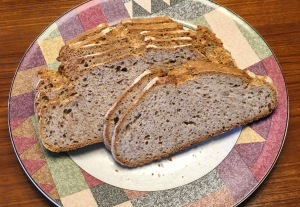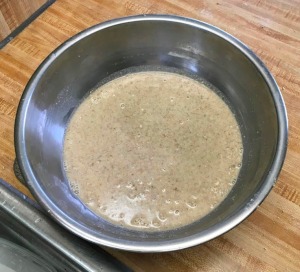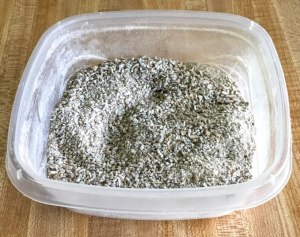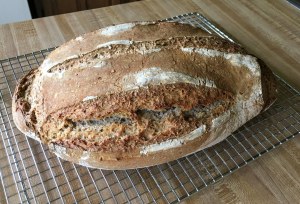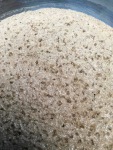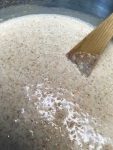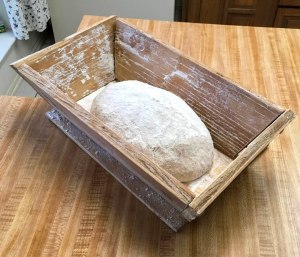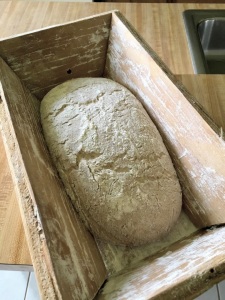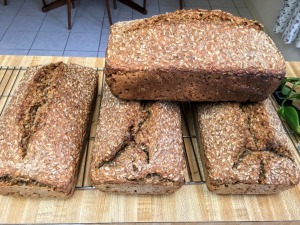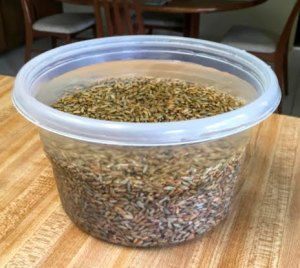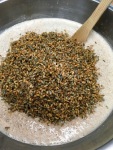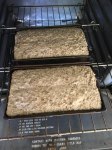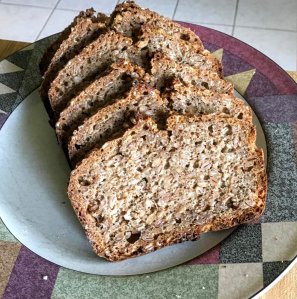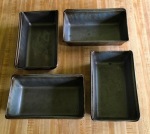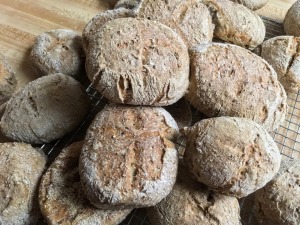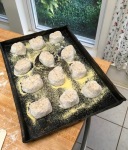Formulas for Baking Sourdough Rye and Wheat Breads
This post tells you how to bake a variety of sourdough breads: rye-wheat bread (Graubrot), rye-wheat bread with whole rye grain (Schwarzbrot), rye-wheat rolls (Brötchen), and wheat bread (Weizenbrot).
If you haven’t done so yet, you may want to read the four preceding posts first. They give an overview of sourdough baking, tell where you can buy grains and flours; discuss the equipment you need for grinding grain, baking, and slicing bread; and describe how you can obtain and maintain the required sourdough starter.
Here is a list of the preceding four posts:
Baking Sourdough Bread: Overview
Purchasing Grains and Flours
Equipment for Grinding Grain, Baking, and Slicing Bread
Getting and Processing Sourdough Starter
General format of baking process
Ingredients
Kneading dough
Rye-wheat bread (Graubrot)
Rye-wheat bread with whole rye grain (Schwarzbrot)
Rye-wheat rolls (Brötchen)
Wheat bread (Weizenbrot)
Note about ingredients
General Format of Baking Process
Our baking process with sourdough has the same general format for all rye and wheat breads. It is spread out over two days.
Day 1
Retrieve sourdough from the stored starter as described in Getting and Processing Sourdough Starter, and combine it with flour, water, and a bit of salt to a soupy mixture. This usually takes 15-30 min. When you click on the photo at left, you see small bubbles rising from the mixture. They indicate that the sourdough bacteria are already at work.
Day 2
18-24 hours later, add more ingredients to the mixture, thus getting a dough. This takes another 15-30 min. Place the dough on a baking sheet or into bread pans and allow it to rise for about 2 hours. At that point, bake the dough for 25-90 min, depending on the particular case.
As you can see, the total time of labor is not much.
Ingredients
Depending on the particular bread, we need coarse rye flour or coarse wheat flour. The sample of coarse rye flour shown in the photo was produced by our Lee Household Flour Mill, running at its coarsest setting.
Note the mixture of cut grains and flour. If your mill cannot produce such a mixture, grind half the grain at the coarse setting, getting the larger kernels, and the rest at the fine setting.
For rye-wheat rolls (Brötchen), we also grind a small amount of rye grain in the finest setting of our mill, getting fine rye flour. Each time you bake rye-wheat rolls, you need maybe half a cup of such flour.
In the case of rye-wheat bread with whole rye grain (Schwarzbrot), we also soak rye grain in water for 18-24 hours, getting soaked rye grain. Here and later, “water” always refers to filtered water, not tap water, since chlorine in tap water harms sourdough bacteria.
We also use the commercially produced wheat flour described in Purchasing Grains and Flours. For brevity, we call it commercial wheat flour.
Kneading Dough
Three of the four breads require kneading of dough. If you are familiar with kneading, skip to the next section.
Various instructional videos make kneading look complicated; just search the Internet for “kneading dough.” Actually, the kneading required in our recipes is simple. The reason is that we have already have achieved a perfect distribution of all ingredients. We just want to add a bit more commercial wheat flour to get the right degree of stiffness.
Kneading consists just of two steps, repeated a number of times:
1. Press down on the lump of dough with both hands, thus stretching it.
2. Fold the stretched dough once to shorten it again.
Each time you do the first step, the dough picks up flour sprinkled on the work area, and thus becomes stiffer and stiffer. You stop when the dough has even consistency, is smooth, and, when placed on a surface area without flour, hardly sticks and can be rolled back and forth with little resistance.
The entire process should take up just a few minutes. In case you would prefer to have a machine do the kneading, just pause for a second and convince yourself that this is good exercise for heart, lungs, and muscles. And you do not have to pay for membership in an exercise club to do it!
Here are the detailed instructions for baking four types of sourdough bread.
Rye-Wheat Bread (Graubrot)
What you need: coarse rye flour, commercial wheat flour, salt.
Day 1
1. Retrieve a 1/4 cup of starter from the stored starter quantity and place it into the mixing bowl. Replenish the starter as described in Getting and Processing Sourdough Starter.
2. Add 3 cups of coarse rye flour, 1 cup of commercial wheat flour, 1 level teaspoon of salt (=5 g), and 4 cups of water.
3. Stir until a soupy mixture results that has no lumps.
4. Cover the mixing bowl.
Day 2
1. The soupy mixture of day 1 seems to have become rather solid: The surface is not quite smooth and has small holes. But looks are deceiving. Just stir the mixture vigorously for several minutes. It will be surprisingly easy to do. In the process, most of the coarse rye flour, having been attacked by the sourdough bacteria for many hours, breaks up, and the mixture turns into mud. You can see that the mixture is alive due to small bubbles that continuously form when you stop stirring for a moment.
2. Gradually add commercial wheat flour, all the while stirring the mixture. The stirring will become progressively harder, until at some point the mixture becomes lumpy and unwieldy, and you cannot stir any more.
3. Wipe down a smooth surface, dry it, and sprinkle on it a layer of commercial wheat flour. Place the lumpy content of the mixture bowl onto that surface. Scrape out the mixture bowl, putting everything on top of the lumpy content. It will look messy, but don’t worry. Everything will eventually be absorbed into the dough.
4. Knead the lumpy pile. It gradually becomes smooth and begins to absorb some of the spread-out commercial wheat flour. Keep on kneading and adding commercial flour to the kneading surface until the dough hardly sticks to a surface without flour and you can roll the dough back and forth with little resistance.
5. Form the dough into an elongated ball. Take some commercial wheat flour and pat it all around the dough. As a result, it no longer sticks at all to a smooth surface.
6. Prepare the basket for rising dough using commercial wheat flour, or dab commercial wheat flour on the inner surfaces of the box constructed according to the specifications in Equipment for Grinding Grain, Baking, and Slicing Bread.
7. Drop the dough ball into the basket or box, place everything into an oven warmed up previously to 110 deg F. Make sure the oven is turned off again. Let the dough rise for 2 hours.
8. Remove the basket or box from the oven. Preheat the oven to 425 deg F. Use shortening to prepare a baking sheet for baking.
9. Move the dough from the basket or box to the baking sheet. For the basket, this is done by tipping the basket sideways and letting the dough roll onto the sheet. For the box, cover the box with the baking sheet, then hold box and baking sheet together and turn them over; then remove the box.
10. Use a knife to carve straight lines into the surface of the dough where you want the crust to break open during the oven spring. We always cut three long lines plus two small perpendicular lines near the ends of the loaf.
11. Preheat the oven to 425 deg F. When the oven has reached that temperature, place the baking sheet with the dough into the oven and bake at 425 deg F for 50 min. The baking time is approximate since temperature control of ovens varies. Start checking 10 min prior to the specified time. Stop when the loaf has a golden-brown crust.
12. Remove the baking sheet with the baked bread from the oven, and let the bread cool on a rack.
The specified quantities result in a bread loaf of approximately 3 1/2 lb. You can scale the ingredients to get larger or smaller loaves. Don’t forget to scale the quantity of salt. You also must adjust the baking time. A smaller loaf calls for a reduced time, and a larger one for a longer time. During the first baking of a loaf of new size, estimate the required time, but check the bread repeatedly as you approach that time.
You can also vary the amount of coarse rye flour and of commercial wheat flour in Day 1 to any values. The formula for water is then as follows.
If you use x cups of coarse rye grain and y cups of commercial wheat flour, then you should add z = 1.14x + 0.5y cups of water. For example, we occasionally bake a monster loaf using x = 7 cups of coarse rye grain and y = 0 cups of commercial wheat flour on Day 1. This requires z = 1.14x +0.5y = 8 cups of water. After the oven spring, the loaf is so huge, it seems to fill the oven. Final weight after 90 min of baking is 8 lb.
You can slice the bread as soon as it has completely cooled off. Store a few slices in a tight box in the refrigerator and the rest in a plastic bag in the freezer. Move slices from the freezer to the refrigerator as needed. Hint: A toasted slice is particularly delicious.
Rye-Wheat Bread with Whole Rye Grain (Schwarzbrot)
What you need: coarse rye flour, rye grain, commercial wheat flour, salt.
Day 1
Steps 1-4 of Day 1 are identical to those of Rye-Wheat bread (Graubrot).
But there are additional Step 5 and 6, listed next.
5. Place into a separate container 4 cups of rye grain. Gradually add water while stirring the grain with a fork. Some of the grain will float to the top of the water, but the stirring action eventually causes all grain to sink below the surface. The water will appear a bit cloudy. This is just some dust that was shipped with the grain.
6. Keep on adding water, and let it spill over the rim of the container until all cloudiness has disappeared. Pour out some of the water, but keep the level considerably above the surface of the grain. Cover the container.
Day 2
1. The soupy mixture of day 1 seems to have become rather solid: The surface is not quite smooth and has small holes. But looks are deceiving. Just stir the mixture in the bowl vigorously for several minutes. It will be surprisingly easy to do. In the process, most of the coarse rye flour, having been attacked by the sourdough bacteria for many hours, breaks up, and the mixture turns into mud. You can see that the mixture is alive due to small bubbles that continuously form when you stop stirring for a moment.
2. Drain the water from the container in which you are soaking the grain. The grain has absorbed quite a bit of the water and has expanded. If you chew on a kernel, you find it to be quite soft.
3. Add the soaked grain to the mixing bowl and stir. This requires some force. Continue stirring until the soaked grain has been evenly dispersed into the muddy mixture.
4. Gradually add commercial wheat flour, all the while stirring the mixture. The stirring will become progressively harder. When the stirring becomes fairly difficult, it is probably time to stop. For a test, lift the stirring spoon with a blob of mixture. If it very slowly creeps down, you should stop. If the blob falls off quickly, you should continue to add flour and stir some more. In a test run, we added 4 1/2 cups of commercial wheat flour.
5. Use shortening to prepare two bread pans for baking. The pans are described in Equipment for Grinding Grain, Baking, and Slicing Bread.
6. Spoon and then scrape the dough into the two bread pans. Smooth the surface. Place the pans into the oven warmed up to 110 deg F. Make sure the oven is turned off again.
7. Let the dough rise. In our experience, this can go fast or slow, depending on several factors. Check the dough after 1 hour, and after that every 30 min.
8. When the dough has risen 1/2 in. beyond the top of the bread pans, it’s time to begin baking. If that has not happened after 2 hours, stop the rising process anyway and begin baking.
9. With a knife carve a line lengthwise into the center of each loaf. The cut will cause the loaf to break up along that line during the oven spring.
10. Leaving the two pans in the oven, preheat the oven to 375 deg F. After about 10 min of Preheat, the oven has reached that temperature. Switch to Bake and start a timer. Bake for 90 min at 375 deg F. The baking time is approximate since temperature control of ovens is not perfect. Check 10 min prior to the specified time, and from then on every 10 minutes. Stop when the crust of the loaf has become golden-brown.
11. Remove the loaves from the bake pans and let them cool on a rack. You now can verify whether your decision to stop baking was correct. The bottom of each loaf should have brown to dark brown color.
If the bottom is light brown, then next time you should increase the baking time a bit. If the bottom has a significant black crust, the baking time should be decreased. In the latter case, the bread can still be consumed. Just scrape off the black material. Do this in your backyard, since the scraped-off black crust breaks up and scatters all over the place.
Slicing of the loaves: The bread is quite dense and hard to slice. Let the loaves cool down over a number of hours. If you have baked in the evening, wait till the next morning. Then place the loaves into freezer bags, but store them for two days in the refrigerator. At that time, they are much easier to slice.
Store the slices in the same freezer bags that held the loaves, and place them into the freezer, except for a few slices stored in a tight box in the refrigerator for immediate consumption. As the bread is consumed, move slices from the freezer to the box in the refrigerator.
If you double the quantities, you get dough for four bread loaves. Baking the four loaves at the same time may seem impossible, at least for the old-style oven we have. But we managed to do so, by bending down the tabs at the ends of the bake pans and arranging the pans in a pattern that allows air to circulate. See the demonstration photo, where we have arranged the baking pans in the desired pattern outside the oven. Baking time is 90 min as before.
Rye-Wheat Rolls (Brötchen)
What you need: coarse rye flour, commercial wheat flour, salt.
All steps of Day 1 and Steps 1-4 of Day 2 are identical to those for Rye-Wheat bread (Graubrot), except that you add 2 cups of coarse rye flour and 2 cups of commercial wheat flour in Step 2 of Day 1 instead of the 3 cups of coarse rye flour and 1 cup of commercial wheat flour called for in Rye-Wheat bread (Graubrot).
When those steps are completed, you have a ball of dough that we now convert into rolls.
The description below begins with Step 5 of Day 2.
Day 2
5. Divide the ball of dough evenly into two halves. Process each of the two pieces as described in Steps 6-9 below.
6. Gently roll the piece of dough back and forth, so that eventually it takes on the shape of a sausage that is about 18 in. long. Sprinkle fine rye flour on the working surface and roll the dough across that flour. The surface will absorb quite a bit of that flour.
7. Slice the roll of dough into 12 or so slices. Each will be about 1 1/2 in. thick.
8. Use shortening to prepare a baking sheet for baking. Instead of shortening, you can also sprinkle a thin layer of corn meal, as we do.
9. Place the 12 slices flat on the baking sheet and carve two crossing lines into the top of each slice. When the rolls rise, the crust will break up at those lines.
10. At this point you have two batches with 12 pieces of dough each, placed on two baking sheets.
11. Place the two batches into an oven warmed up to 110 deg F. Make sure the oven is turned off again. Let the dough rise for 2 hours.
12. Remove the two batches from the oven. Preheat the oven to 425 deg F. Then bake the two batches at 425 deg F for 25 min. The baking time is approximate since temperature control of ovens is not perfect. Check 5 min prior to the specified time. As soon as the rolls have become slightly brown, they are done. If you bake too long, the crust will become quite hard.
13. Remove the batches from the oven, and let the rolls cool on a rack.
14. Once the rolls are at room temperature, store them in a plastic bag in the freezer.
For consumption, defrost and warm up a roll for 20 sec in a microwave oven, slice it in half, and toast the two halves. You end up with two crispy and tasty halves.
If the rolls do not rise enough in Step 11, expand Step 5 by allowing the ball of dough to rise for 1 hour in the mixing bowl at room temperature before you cut the ball of dough into two halves.
You can vary the composition of the rolls by reducing or increasing the portion of coarse rye grain. That is, you always use a total of 4 cups of flour on Day 1, but vary how many of them are coarse rye flour. Accordingly, the rolls become fluffier or denser.
You can make baguettes instead of Broetchen, using the dough on hand at the beginning of day 2. Divide the dough into two halves, and shape each into a longish loaf. Place the two loaves on a cookie sheet and let them rise for 2 hours. Divide each loaf into three even pieces. Roll each of them into a long baguette. Place the resulting six baguettes onto two cookie sheets, and cut them lengthwise with a knife. Let them rise for another hour, then bake at 450 deg F for 30 min or until the top has a light brown crust.
Wheat Bread (Weizenbrot)
What you need: coarse wheat flour, commercial wheat flour, salt; for the replenishment of the starter, coarse rye flour.
The process is exactly the same as for Rye-Wheat Bread (Graubrot) except that in Step 2 of Day 1 you use coarse wheat flour instead of coarse rye flour. If you are adventurous, you can also soak a handful of wheat grain, but not more, in water on Day 1 and add the soaked wheat grain to the mixture at the beginning of Day 2.
Note about Ingredients
When you scan recipes for breads on the Internet, you come across numerous ways to improve the bread by addition of various nuts and seeds. In our opinion, this is a mistaken choice. The bread gains lots of calories, and the taste of the bread is no longer simple and satisfying. So, you may want to overcome that temptation and avoid those additions.
Post Navigation
Baking Sourdough Bread: Overview
Purchasing Grains and Flours
Equipment for Grinding Grain, Baking, and Slicing Bread
Getting and Processing Sourdough Starter
Formulas for Baking Sourdough Rye and Wheat Breads ← You are here
Have any questions or feedback about the formulas for baking sourdough bread? Please share your thoughts in the comments.
